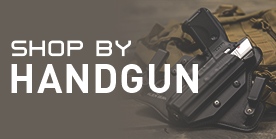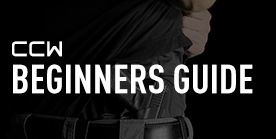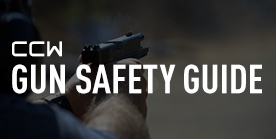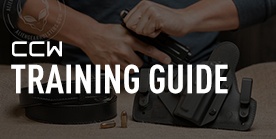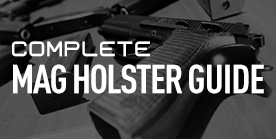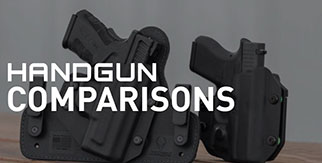
Almost Everything You Need To Know About Handgun Ammunition
Obviously a person should learn to choose a gun, but also know how to choose ammunition for it. Ammunition, just like a pistol, is a tool and every tool has an ideal purpose. As a result, certain kinds of ammunition have a definite purpose.
This guide will give the beginner the basics of the various types of ammunition that are available in most gun stores, and what to look for. After all, if you are going to put a concealed carry gun in your holster and carry, you may as well have it loaded with the right ammo.
Basic Anatomy Of A Bullet

There are a few basic components of a bullet, or more strictly speaking, a cartridge. A "bullet" is actually the projectile; the cartridge is the entire round. However, many people use the terms interchangeably though it perhaps shouldn't be.
The bullet itself is the projectile, which is shot out of the barrel. Most bullets have a core of lead or other soft metal, encased in a hard metal shell or "jacket."
The case is the shell that holds the entire cartridge together. Usually they are brass, but some are steel...though not every firearm digests steel case ammunition well.
Inside the case is propellant, an explosive powder that - when set off - explodes, sending the bullet out of the barrel.
The rim is the rear of the bullet. Most cartridges for semi-automatics are called "rimless" in that the rim is the same diameter as the case. Revolver cartridges have a larger rim, so they sit flush against the cylinder. There are some semi-rimmed cartridges out there - such as .38 Super and .38 ACP - but they are rare in this day and age.
The primer is a small cap inserted in the center of the rear of the cartridge. This contains a small charge of powder that - when the primer is struck - produces a small spark that discharges the main propellant charge.
The type of ammunition is generally determined by what kind of projectile is seated in the case.
Full Metal Jacket or FMJ Ammunition

The most common type of ammunition is full metal jacket, or FMJ. Full metal jacket rounds have a core of soft metal - usually lead - completely surrounded by a "jacket" of hard metal, usually copper. Since the core is wholly enclosed in metal, hence the designation of "full metal jacket."
It's also referred to as "ball" or "hardball." Many FMJ rounds are still rounded, almost like a ball shape.
FMJ rounds are generally not the best rounds for CCW ammo. With proper shot placement they can be serviceable, but no more. A fully jacketed round will go through most targets, including soft targets such as a body. In a residential setting, use of FMJ rounds for defensive purposes is a recipe for disaster, as even a moderate FMJ round will go through an attacker, through any walls and potentially into someone else in the household.
Since FMJ rounds are also generally the cheapest, as well as not being the best defensive rounds, this makes them the best practice ammunition. This is what the average person uses hardball for and in truth, is what the average person should be using it for.
JHP or Jacketed Hollow Point Ammunition: The Standard For Defensive Rounds

The gold standard for defensive ammunition is the jacketed hollow point, or JHP. Hollow point ammunition has a depression in the middle or a hole through the center of the round, exposing the soft metal core but while still having a jacket of hard metal.
The effect of this construction method is that when the round enters soft tissue, the shock of doing so causes the bullet to "mushroom" out, expanding while inside the target. This has the dual effect of creating a larger wound cavity but also slowing the projectile down, bringing it to a stop ideally within the target.
The JHP round works far better at stopping a target because of these attributes, and has a track record stretching back almost a century supporting it. As a result, police departments issue JHP rounds and civilians buy them for carry.
Polymer Tipped Rounds

In recent years, a number of ammunition manufacturers have begun producing polymer-tipped rounds for carry purposes. There is more than one impetus at work for such ammunition.
One of the first polymer-tipped rounds was LEVERevolution by Hornady. These rounds are rifle rounds with a polymer tip that was developed for use in tube-magazine fed lever action rifles. The sharp-tipped boattail bullet design - called a Spitzer bullet - that is used without issue in bolt-action rifles cannot be used in lever-action rifles such as a Marlin, Henry or Winchester lever-action as the sharp tip rests on the primer of the next round. Any violent motion - such as firing the gun - could set off the rounds in the magazine. The polymer tip allows the spitzer bullet design to be used in such a rifle.
Other polymer tips, such as Hornady's Critical Defense line, seat a polymer tip on a hollowpoint round in order to give the bullet the flight performance of a spitzer bullet but the expansion of a hollowpoint upon impact.
If a person anticipated longer shooting distances or having to penetrate several objects before the round reached the target, this would seemingly be the round to acquire. However, penetration sometimes comes at the cost of reliable expansion.
Frangible Rounds

Frangible bullets are designed to fragment upon entering the target. They are made from a brittle metal, often enough a powdered metal pressed into a mold. Upon entering a soft tissue target, they will break up into many smaller parts. Upon striking a hard target, frangible bullets disintegrate. However, depending on the formulation of the bullet, it may still penetrate certain materials such as drywall, clothing or other softer materials without fragmenting.
Frangible rounds are useful for a number of purposes. Many hunting rounds have a frangible core and will break up upon entering the quarry. Additionally, frangibles are immune to ricochet; any material hard enough to produce one will pulverize a frangible round. That makes them ideal for urban environments. Some people prefer frangibles for shooting steel plate targets for this reason.
Some frangible rounds are also capable of penetrating soft body armor designed to stop solid rounds. In all, frangible bullets are very serviceable defensive rounds, though they do not produce the large wound channels hollowpoints do.
Wadcutters And Semi-Wadcutters

Wadcutter rounds, and the closely-related semi-wadcutter rounds, are designed to create large wounds by means of the bullet shape. Wadcutter rounds are the "flying ashtray" round; they are literally flying cylinders that punch a large hole in a target.
Semi-wadcutters have a wadcutter base with the cone of a bullet protruding from it with a small rim at the base of the projectile. Before quality hollowpoints became widely available, the semi-wadcutter was the standard defensive round. Some of the most popular defensive loadings was the 158-grain lead-semi-wadcutter hollowpoint round in .38 Special and also .357 Magnum. However, because semi-autos are more touchy regarding rounds they will chamber, semi-wadcutters are typically - though not exclusively - best-suited for use in a revolver.
Semi-wadcutters will penetrate a target well, but also punch a larger hole than FMJ rounds. Since they are often cast in soft metal (and usually lead) the bullet will also expand in the target. The slower, soft lead bullets of the 19th century expanded in tissue unlike the fast, jacketed rounds of the smokeless powder era. The SWC round, until the hollowpoint was perfected, was the best defensive round available.
Wadcutters are too slow and don't penetrate well enough for defensive use, but are great practice rounds. SWC rounds, and the LSWCHP rounds, however, are great for personal defense and are also highly-regarded for use as handgun hunting rounds.
Over-Pressure: Plus P and Plus P Plus

A good number of defensive rounds are the Plus P (+P) and Plus P-Plus (+P+) rounds, which are over-pressure rounds.
Ammunition produces pressure when powder ignites; this is what sends the bullet out of the barrel. The two global standards organizations that govern ammunition (CIP and SAAMI) set a standard pressure level for a given cartridge. For instance, standard pressure for 9x19mm Parabellum (common 9mm) is given as about 34,000 pounds per square inch (PSI) of pressure, .45 ACP is rated at about 20,000 PSI.
A round loaded with a bit more powder than a standard pressure round produces more pressure, ergo overpressure and Plus P. The Plus P designation, however, is a more recent invention, as the CIP and SAAMI have both acknowledged a ceiling to the +P designation, usually 1,000 to 2,000 PSI over standard pressure. Anything beyond that is Plus-P-Plus.
Using Plus P Ammunition

Use of Plus P ammunition should involve an abundance of caution, as correct use of ammunition is a component of good gun safety. Make sure you read your firearm's owner's manual carefully, as that will usually give you the guidelines on how best to use +P ammo in your pistol.
Some firearms are rated for continuous use of Plus P ammunition, some are not rated for Plus P ammunition at all. Some firearms recommend that Plus P ammo is used sparingly, as it will accelerate wear and tear.
Follow the manufacturer's recommendations, as they engineered the gun and know better than you do about what's safe for use in your firearm.
Many people practice with standard pressure, but carry a Plus P round.
The purpose behind Plus P ammunition is that it gives the projectile additional velocity, ostensibly making penetration more reliable. Since Plus P rounds have a good track record in police service (most departments carry +P if not +P+) there is something to the idea, even though the gains in velocity (often it's about an extra 100 feet per second, if not less, for the same round) are rather moderate.
That said, there are plenty of standard pressure loadings that are perfectly viable defensive loadings, so it's up to you to decide if you should carry +P.
Choosing CCW Ammunition

There are a few aspects one should look for when choosing carry ammunition. First and foremost are that you should use carry ammunition that cycles reliably and that you can shoot accurately. If it doesn't group well, and doesn't shoot reliably, then it's not good ammunition for you.
You should also find a defensive load that has a track record of reliable penetration and expansion. Find out what police in your area carry, if possible. Some common duty ammo for police includes Federal Hydra-Shok and HST, Remington Golden Saber and Ranger lines, and Speer's Gold Dot loads.
There are many more, however, and some people prefer to load their own.
That said, if you find a defensive ammunition load that has the pedigree and testing history, cycles well and that you can shoot well, that's a great load for you to carry.
 |
About The Author Born in southeastern Washington State, Sam Hoober graduated in 2011 from Eastern Washington University. He resides in the great Inland Northwest, with his wife and child. His varied interests and hobbies include camping, fishing, hunting, and spending time at the gun range as often as possible. |


